Ames W.F., Roger C. Nonlinear equations in the applied sciences. Volume 185
Подождите немного. Документ загружается.

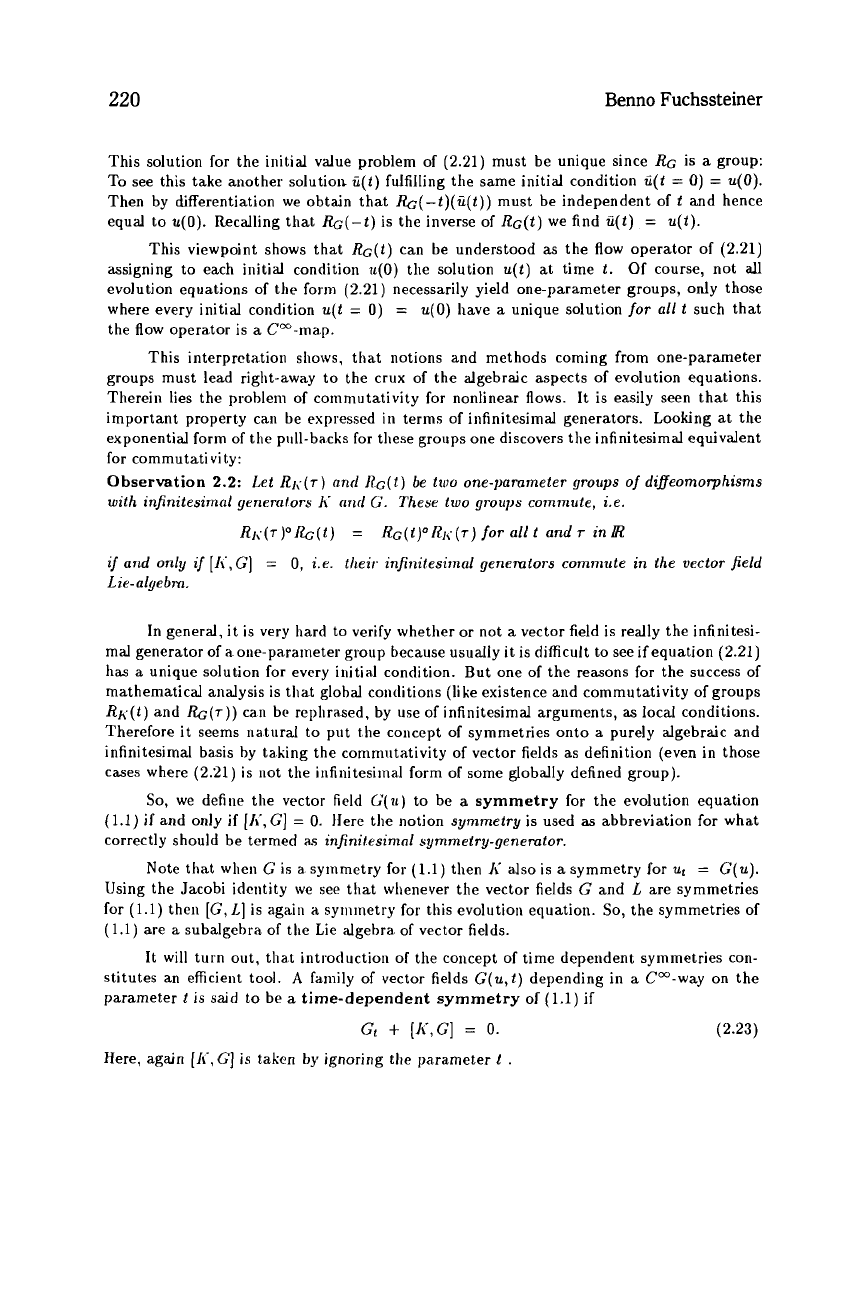
220
Benno Fuchssteiner
This solution for the initial value problem
of
(2.21) must be unique since
Rc
is
a
group:
To
see this take another solution
ii(t)
fulfilling the same initial condition
ii(t
=
0)
=
u(0).
Then by differentiation we obtain that
&(-t)(G(t))
must be independent of
t
and hence
equal to
u(0).
Recalling that
&(-t)
is the inverse of
Rc(t)
we find
G(t)
=
u(1).
This viewpoint shows that
RG(t)
can be understood as the flow operator
of
(2.21)
assigning to each initial condition
u(0)
the solution
~(t)
at
time
t.
Of course, not
all
evolution equations
of
the form (2.21) necessarily yield one-parameter groups, only those
where every initial condition
u(t
=
0)
=
u(0)
have
a
unique solution
for
all
t
such that
the flow operator is
a
C"-map.
This interprcta.tion shows, that notions and methods coming from one-parameter
groups must lead right-away to the crux
of
the algebraic aspects
of
evolution equations.
Therein lies the problem
of
commutativity for nonlinear flows. It is easily seen that this
important property can be espressed
in
terms of infinitesimal generators. Looking at the
exponential form
of
the pull-backs for these groups one discovers the infinitesimal equivalent
for commutativity:
Observation
2.2:
Let
RI;(T)
and
I?c(t)
be
two
one-parameter groups
of
difleomorphisms
with
infinitesimal generators
I<
arid
G.
These
two
groups commute,
i.e.
Rl;(r)O&(t)
=
RG(t)ORJ;(r)
for
allt
andr inR
if
and
only
if
[I<,G]
=
0,
i.e.
their infinifesimnl genemtors commute in the
vector
field
Lie-
alge
bm.
In general, it is very hard to verify whether or not
a
vector field is really the infinitesi-
mal generator of
a
one-parameter group because usually
it
is difficult to see if equation (2.21)
has
a
unique solution for every initial condition. But one
of
the reasons for the success of
mathematical analysis is that glohal conditions (like existence and commutativity of groups
Rh.(t)
and
&(r))
call be rephrased, by use of infinitesimal arguments,
as
local conditions.
Therefore it seems natural to put the concept
of
symmetries onto
a
purely algebraic and
infinitesimal basis hy taking the coninintativity
of
vector fields as definition (even in those
cases where (2.21) is not the infinitesimal form
of
some globally defined group).
So,
we define the vector field
G(u)
to be
a
symmetry
for the evolution equation
(1.1) if and only
if
[A',
G]
=
0.
Here the notion
symmetry
is used
as
abbreviation for what
correctly should be termed
as
znjinifeszmnl
symmetry-generator.
Note that when
G
is
a
symmetry for
(1.1)
then
li
also
is
a
symmetry
for
ut
=
G(u).
Using the Jacohi identity we see that whenever the vector fields
G
and
L
are symmetries
for
(1.1)
then
[G,
L]
is again a syinmetry for this evolution equation.
So,
the symmetries
of
(1.1)
are
a
subalgehra
of
the Lie algehra
of
vector fields.
It will turn out, that introduction
of
the concept
of
time dependent symmetries con-
stitutes an efficient tool.
A
family
of
vector fields
G(u,t)
depending in
a
C"-way on the
parameter
t
is
said
to be
a
time-dependent symmetry
of (1.1) if
Gt
+
[l<,G]
=
0.
Here, agajn
[I<,
G]
is taken by ignoring
the
parameter
1
(2.23)
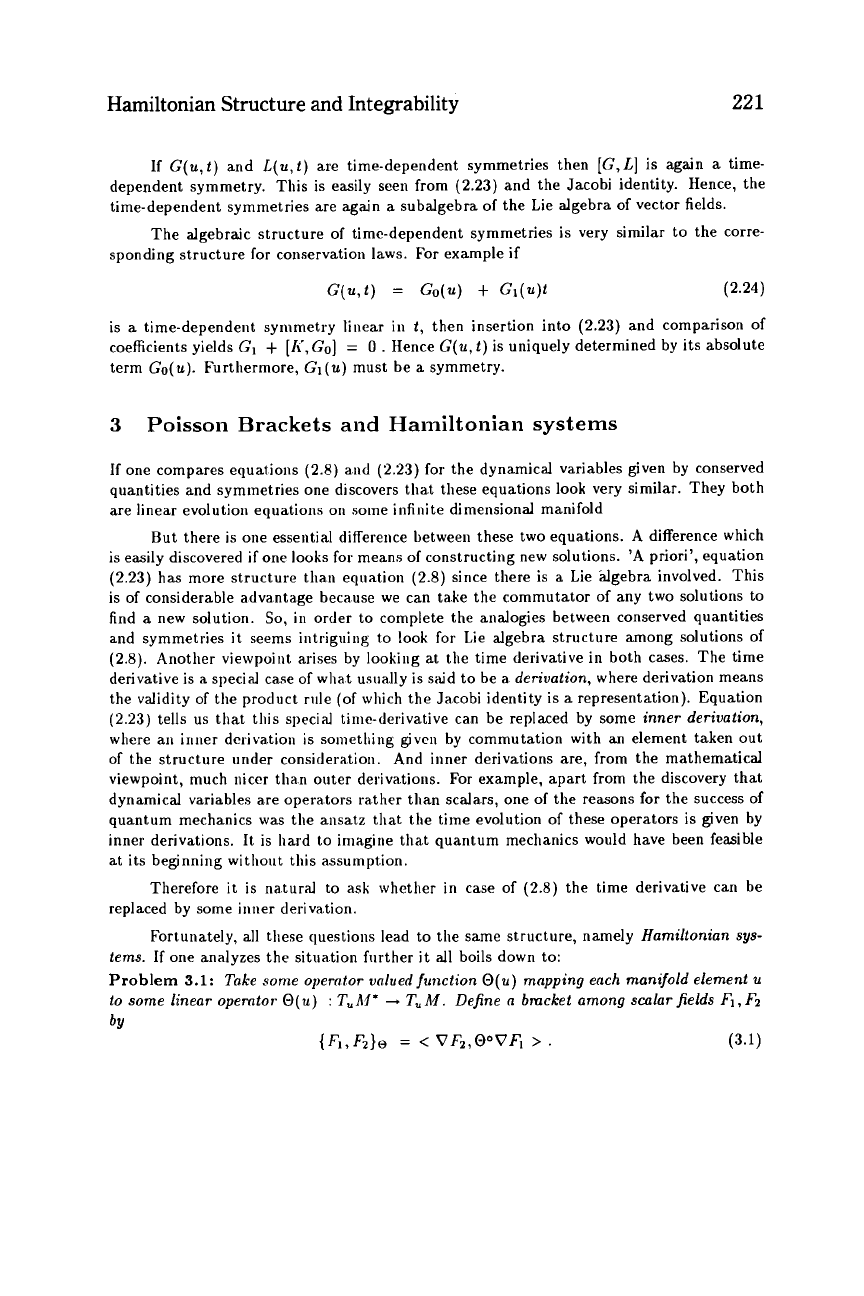
Hamiltonian Structure
and
Integrability
22
1
If
G(u,t)
and
L(u,t)
are time-dependent symmetries then
[G,L]
is
again
a
time-
dependent symmetry. This is easily seen from
(2.23)
and the Jacobi identity. Hence, the
time-dependent symmetries are again
a
subalgebra
of
the Lie algebra of vector fields.
The algebraic structure
of
time-dependent symmetries is very similar to the corre-
sponding structure for conservation laws. For example if
G(u,t)
=
Go(u)
+
GI(U)t
(2.24)
is
a
time-dependent symmetry linear in
1,
then insertion into
(2.23)
and comparison of
coefficients yields
GI
+
[Ii,Go]
=
0
.
Hence
G(u,t)
is uniquely determined by its absolute
term
Go(u).
Furthermore,
GI(u)
must be
a
symmetry.
3
Poissoii
Brackets
and
Haiiiiltoiiiaii systems
If one compares equations
(2.8)
a.nd
(2.23)
for the dynamical variables given by conserved
quantities and symmetries one discovers t1ia.t these equations look very similar. They both
are linear evolution equations
on
some infinite dimensional manifold
But there
is
one essential difference between these two equa.tions.
A
difference which
is easily discovered
if
one
looks
for means
of
constructing new solutions.
'A
priori', equation
(2.23)
has more structure than equation
(2.8)
since there is
a
Lie glgebra involved. This
is of considerable advantage because we can ta.ke the commutator of any two solutions to
find
a
new solution.
So,
in
order to complete the analogies between conserved quantities
and symmetries it seems intriguing t.o
look
for Lie algebra structure among solutions
of
(2.8).
Another viewpoint arises by looking at the time derivative in both cases. The time
derivative is
a
special rase of what usually is said to be
a.
derivation,
where derivation means
the validity of the product ride
(of
which the Jacobi identity is
a
representation). Equation
(2.23)
tells
us
that this special time-derivative can be replaced by some
inner derivation,
where
an
inner deriva.tion is something given by commutation with
an
element taken out
of the structure under consideration. And inner derivations are, from the mathematical
viewpoint, much nicer than outer deriva.tions.
For
example, apart from the discovery that
dynamical variables are operators rather than scala.rs, one
of
the reasons for the success of
quantum mechanics was the ansatz that the time evolution of these operators is given by
inner derivations. It is hard to imagine t1ia.t quantum mechanics would have been feasible
at its beginning without this a.ssumpt,ion.
Therefore it is natural to
ask
whether in case of
(2.8)
the time derivative can be
replaced by some inner deriwtion.
Fortunately, all these questions lead to the same structure, namely
Hamiltonian sys-
tems.
If one analyzes the situation further it all boils down to:
Problem
3.1:
Take
some
operotor
volued function
O(u)
mapping each manifold element
u
to
some linear operator
O(u)
:
TUM*
-
TuA4. Define a brncket among
scalar
fields
F1,Fz
by
{Fi,Fz}o
=
<
VFz,OoVFi
>.
(3.1)
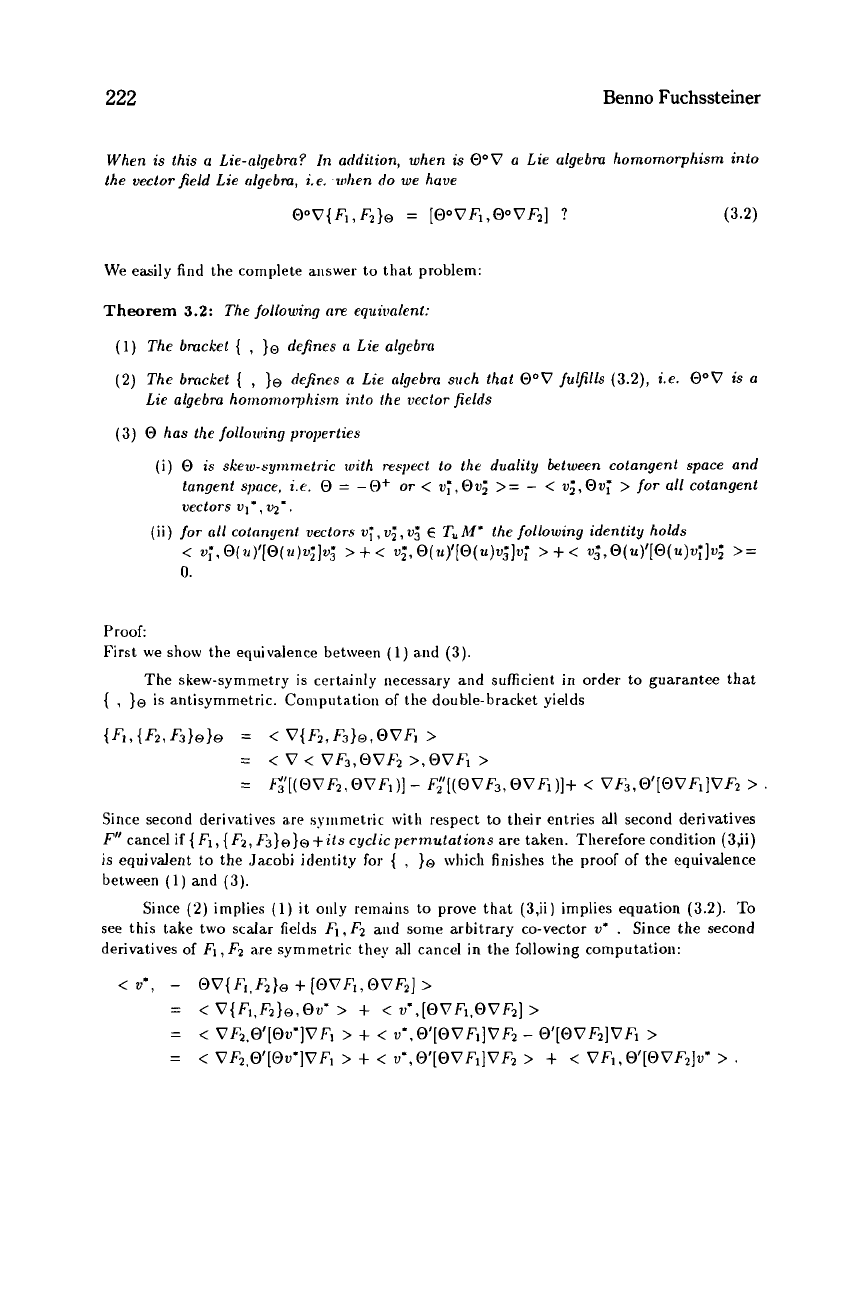
222
Benno
Fuchssteiner
When is this
a
Lie-algebra?
In
addition, when is
OoV
a
Lie algebm homomorphism into
the vectorfield Lie olgebm, i.e. uihen do we have
OoV{Fl,Fz}~
=
[@"VFi,0°VF2]
?
(3.2)
We easily find the complete answer to that problem:
Theorem
3.2:
The
Jollouting
are
eqtiivalent:
(1)
The bmcket
{
,
}e
defines
a
Lie
algebra
(2)
The bracket
{
,
}e
defines
a
Lie
algebra such that
OoV
Ju&lls
(3.2),
i.e.
OOV
is
a
Lie algebra homomorphism into the vector fields
(3)
0
has the Jollotoing properties
(i)
0
is shew-symmetric with respect to the duality between cotangent space and
tangent space, i.e.
0
=
-O+
or
<
v;,Ov;
>=
-
<
v;,Ov;
>
for all cotangent
vectors
v1
*
,
v2*.
(ii)
for
all
cotnngenf vectors
v;,v;,vj
E
T,,A4*
the following identity holds
<
v;,O(u)"O(u)v;]v;
>
+
<
v;,O(u)'p(u)v;]v;
>+<
v;,O(u)~[O(u)v;]v;
>=
n.
Proof:
First we show the equivalence between
(1)
a.nd
(3).
{
,
}e
is antisymmetric. Computation
of
the double-bracket yields
{Flt{F2?F3}8}0
=
<
V{Fz,F3}e,OVFt
>
The skew-symmetry is certainly necessary and sufficient in order to guarantee that
=
=
<
V
<
VF3,OVFz
>,OVFi
>
Fj"(OVFz,OVFl)]
-
F;"(OVF3,OVF1)]+
<
VF3,O'[OVFi]VFz
>
Since second derivatives are symmetric with respect to their entries
all
second derivatives
F"
cancel
if
{
F1,
{
Fz,
F3}e}o
+
its
cyclic permutations
are taken. Therefore condition (3ji)
is equivalent to the Jacobi identity for
{
,
}@
which finishes the
proof
of
the equivalence
between
(1)
and
(3).
Since
(2)
implies
(1)
it
only
remains to prove that (3,ii) implies equation
(3.2).
To
see this take two scalar fields
Fl,
Fz
and some arbitrary co-vector
v*
.
Since the second
derivatives
of
FI,
F2
are symmetric they
dl
cancel in the following computation:
<
v*,
-
OV{F,,F*}e
+[OVFI,OVF2]
>
=
<
V{Fi,Fz}e,Ou*
>
t
<
v*,[OVFi,OVFz]
>
=
=
<
VF~,O'[OV*]VF~
>
t
<
v*,O'[OVFI]VF~
>
+
<
VFI,O'[OVF~]V*
>
.
<
VF*,O'[OV*]VFI
>
t
<
v*,O'[OVFI]VF~
-
O'[OVFz]VFi
>
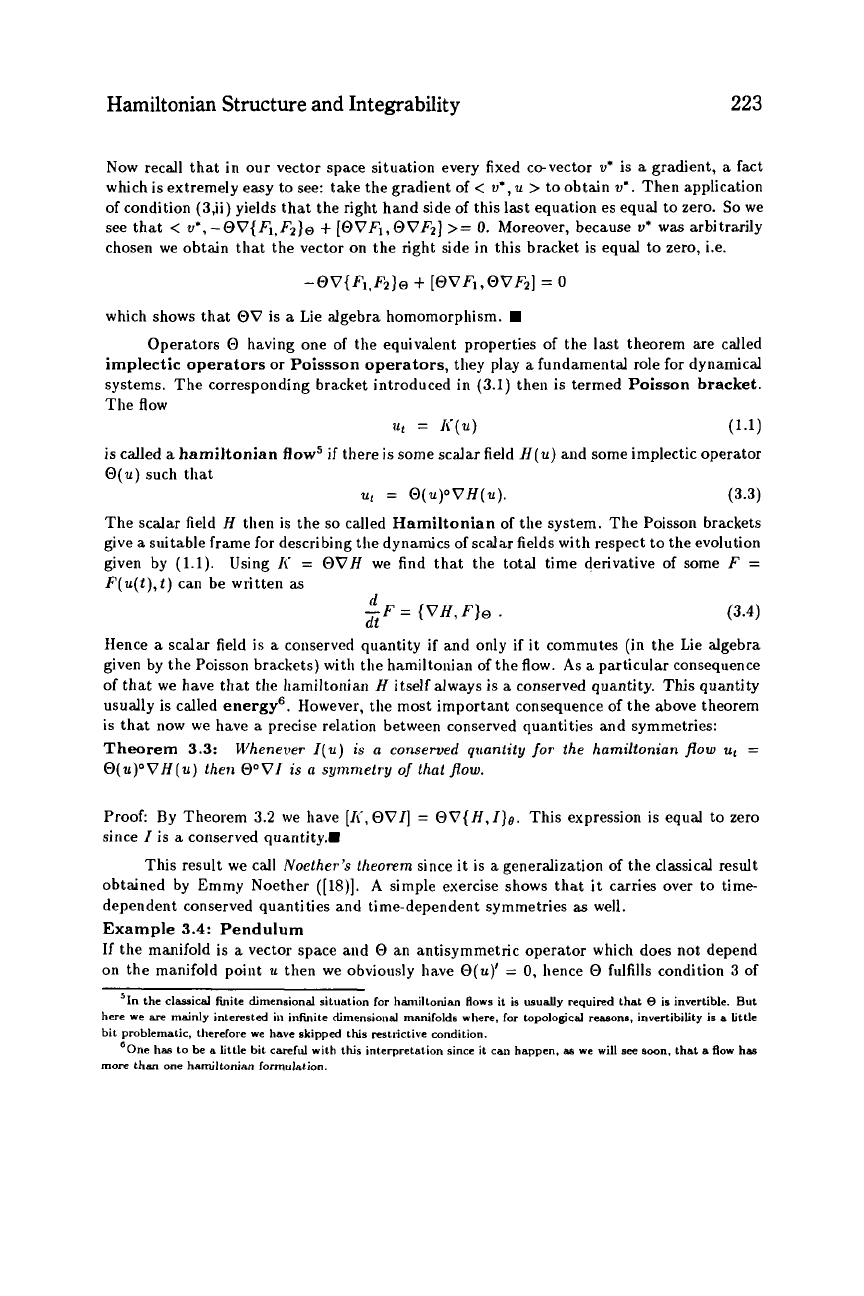
Hamiltonian Structure and Integrability
223
Now recall that in
our
vector space situation every fixed co-vector
v*
is
a
gradient,
a
fact
which is extremely easy to see: take the gradient of
<
v*,
u
>
to obtain
v*.
Then application
of condition
(35)
yields that the right hand side of this last equation es equal to zero.
So
we
see that
<
v',-OV{Fl,F2}~
+
(OVfi,OVfiJ
>=
0.
Moreover, because
v*
was arbitrarily
chosen we obtain that the vector on the right side in this bracket is equal to zero, i.e.
-Ov{Fl,F2}Q
+
[OvFl,OvF2]
=
0
which shows that
OV
is
a
Lie algebra homomorphism.
Operators
0
having one
of
the equivalent properties of the last theorem are called
implectic operators
or
Poissson operators,
they play
a
fundamental role for dynamical
systems. The corresponding bracket introduced in
(3.1)
then is termed
Poisson bracket.
The flow
7lt
=
K(u)
(1.1)
is called
a
hamiltonian
flow5
if there
is
some scalar field
H(u)
and some implectic operator
O(
u)
such that
The scalar field
H
then is the
so
called
Hamiltonian
of tlie system. The Poisson brackets
give
a
suitable frame
for
describing
tlie
dynamics
of
scalar fields with respect to the evolution
given by
(1.1).
Using
Ii
=
OVH
we find that the total time derivative
of
some
F
=
F(u(t),t) can be written as
ut
=
O(u)OVH(u).
(3.3)
(3.4)
d
-F
=
{VH,F)Q
.
dt
Hence
a
scalar field is
a
conserved quantity
if
and only
if
it commutes (in the Lie algebra
given by the Poisson brackets) with the hamiltonian of the flow.
As
a
particular consequence
of
that we have that the Iiamiltonian
H
itself always is
a
conserved quantity.
This
quantity
usually is called
energy6.
However, the most important consequence of the above theorem
is that now we have
a
precise relation between conserved quantities and symmetries:
Theorem
3.3:
O(u)"VH(u)
then
OnVI
is
(I
symmetry
of
that
pow.
Wheneoer
I(u)
is
a conserved quantity
for
the hamiltonian
pow
ut
=
Proof: By Theorem
3.2
we have
[A',
OVI]
=
OV{
H,
1)~.
This expression is equal to zero
since
I
is
a
conserved quantity..
This result we call Noether's theorem since it is
a
generalization of the classical result
obtained by Emmy Noether
([lS)].
A
simple exercise shows that it carries over to time-
dependent conserved quantities and time-dependent symmetries
as
well.
Example
3.4:
Pendulum
If the manifold
is
a
vector space and
O
an antisymmetric operator which does not depend
on the manifold point
ti
then we obviously haxe O(u)'
=
0,
hence
0
fulfills condition
3
of
'In
the clzasical hile dimensional situation lor hamiltonian
flows
it
is
usually required that
Q
is
invertible. But
here we
are
mainly interested in infinite dimensional manilolds where,
lor
topological reasons. invertibilily
is
a litlle
bit problematic. therelore
we
have skipped
this
restrictive condition.
60ne
has
lo
be
a
titlle bit
carelul
with
this interpretation since it can happen.
m
we will
see
soon, that
a
flow
has
more
than
one hamiltoninn
formulntion.
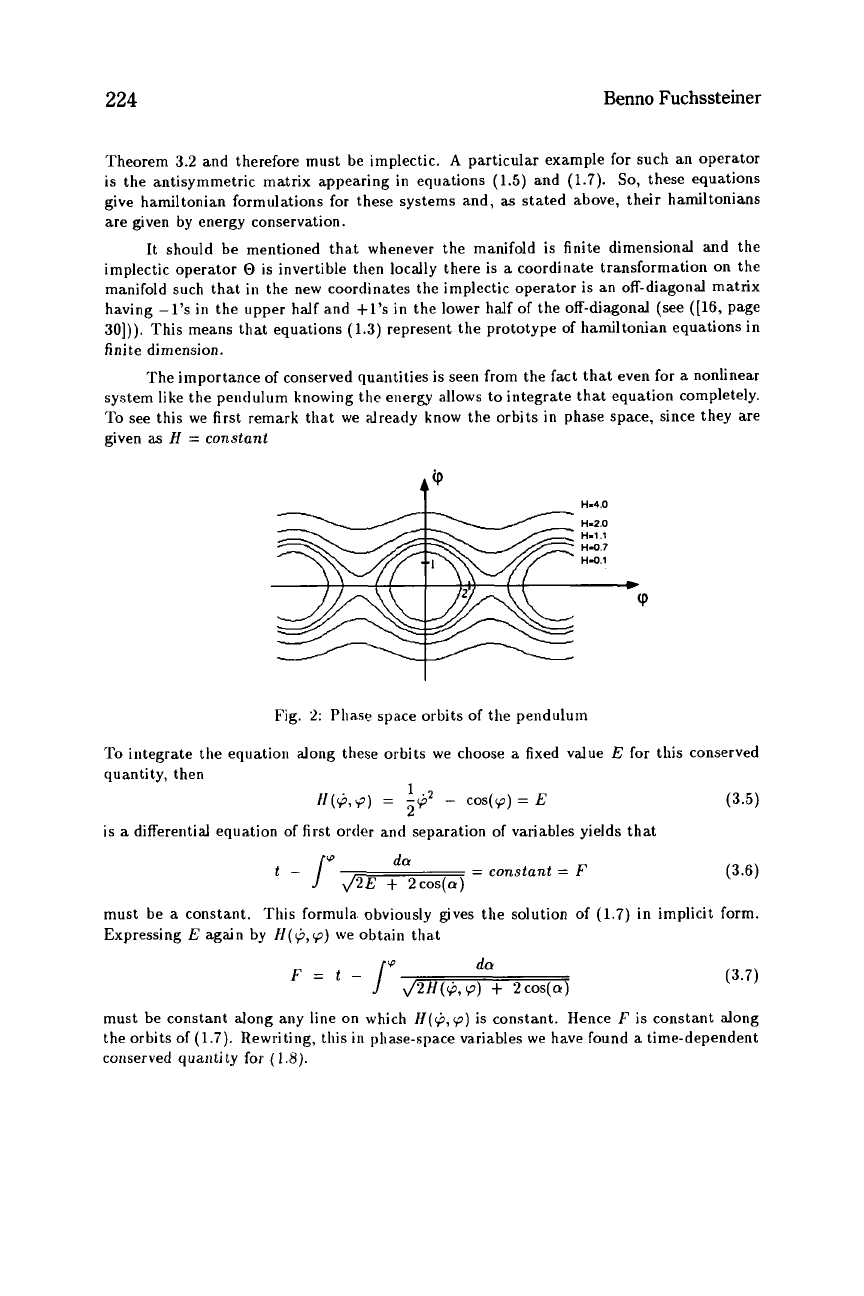
Benno
Fuchssteiner
224
Theorem 3.2 and therefore must be implectic.
A
particular example for such an operator
is the antisymmetric matrix appearing in equations
(1.5)
and
(1.7).
So,
these equations
give hamiltonian formulations for these systems and,
as
stated above, their hamiltonians
are given by energy conservation.
It should be mentioned that whenever the manifold
is
finite dimensional and the
implectic operator
0
is
invertible then locally there is
a
coordinate transformation on the
manifold such that
in
the new coordinates the implectic operator is an off-diagonal matrix
having
-1's
in the upper half and
+l's
in the lower half
of
the off-diagonal (see
([16,
page
301)). This means that equations
(1.3)
represent the prototype of hamiltonian equations in
finite dimension.
The importance of conserved quantities
is
seen from the fact that even for
a
nonlinear
system like the pendulum knowing the energy allows to integrate that equation completely.
TO
see this we first remark that we already know the orbits in phase space, since they are
given
as
H
=
constant
H-4.0
H-2.0
H-1
.l
H-0.1
~-0.7
___)
u,
Fig.
2:
Phase space orbits
of
the pendulum
To
integrate the equation along these orbits we choose
a
fixed value
E
for this conserved
quantity, then
(3.5)
1.
2
fI(+,+Y)
=
-92
-
cos(9)
=
E
is
a
differential equation
of
first order and separation
of
variables yields that
(3.6)
da
=
constant
=
F
-
J'
J2E
+
2cos(a)
must be
a
constant. This formula obviously gives the solution
of
(1.7)
in implicit form.
Expressing
E
again by
CI(+,v)
we obtain that
(3.7)
F=t-/'
da
J211(+,9)
+
2cos(a)
must be constant along any line on which
H(+,
9)
is constant. Hence
F
is constant along
the orbits
of
(1.7).
Rewriting, this
in
phase-space variables we have found
a
time-dependent
conserved quantity
for
(1.8).
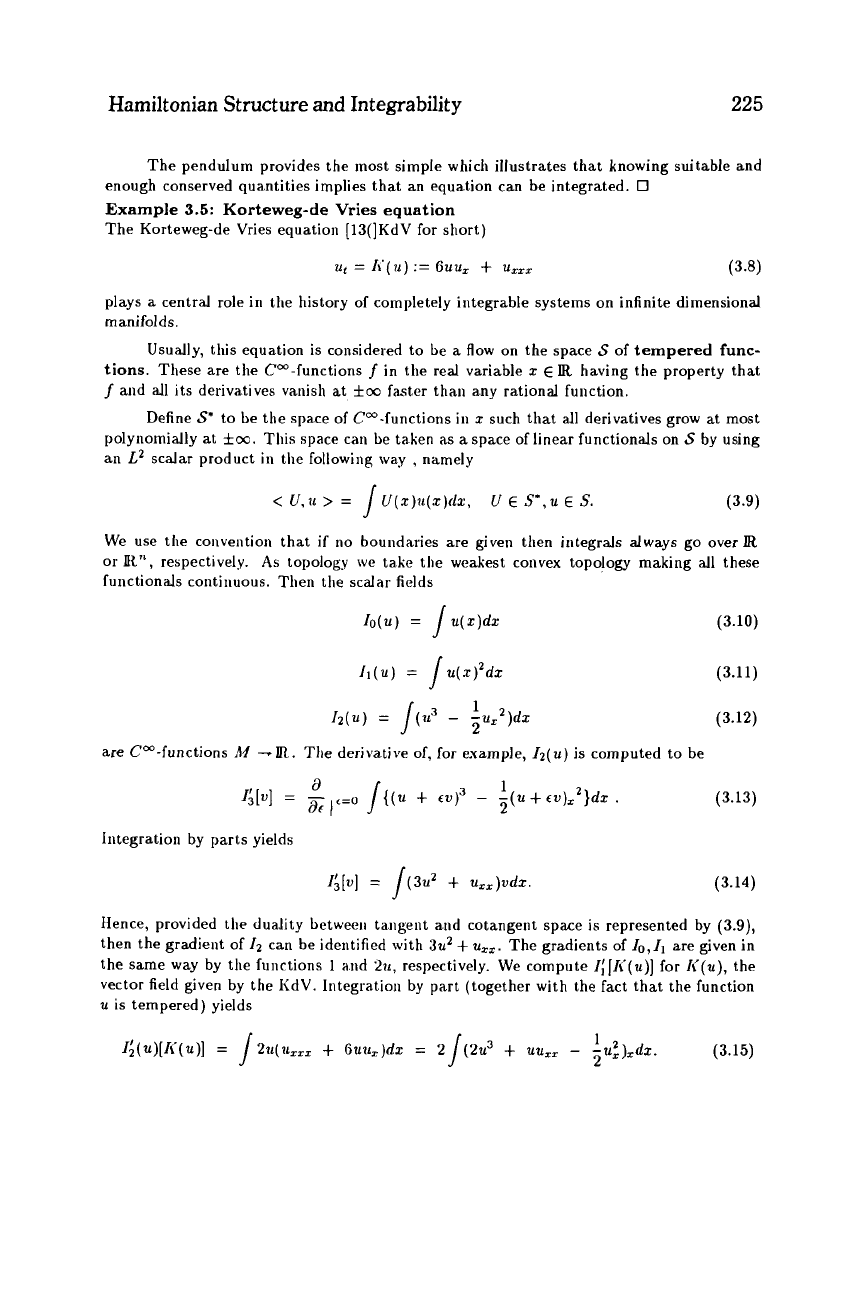
Harniltonian Structure
and
Integrability
225
The pendulum provides the most simple which illustrates that knowing suitable and
enough conserved quantities implies that an equation can be integrated.
0
Example
3.5:
Korteweg-de
Vries
equation
The Korteweg-de Vries equation
[13(]KdV
for
short)
7~1
=
K(
71)
:=
GUU,
+
u,,
(3.8)
plays
a
central role in the history
of
completely integrable systems on infinite dimensional
manifolds.
Usually, this equation is considered
to
be
a
flow on the space
S
of
tempered
func-
tions.
These are the Coo-functions
f
in the real variable
x
E
IR
having the property that
f
and
all
its derivatives vanish at
fcc
faster than any rational function.
Define
S’
to be the space
of
CW-functions
in
2
such that all derivatives grow at most
polynomially at
koo.
This space can be taken
as
a
space
of
linear functionals on
S
by using
an
Lz
scalar product in the following way
,
namely
<
u,71
>
=
Ju(x)71(2)ex,
u
E
S.,u
E
s.
(3.9)
We use the convention that
if
no
boundaries are given then integrals always
go
over
IR
or
EL”,
respectively.
As
topology we take the weakest convex topology making
all
these
functionals continuous. Then the scalar fields
10(u)
=
Ja(x)dx
(3.10)
(3.11)
1
Iz(u)
=
J(7a
-
2u,2)dr
(3.12)
are Cm-functions
A4
-lR.
The derimtive
of,
for
example,
Iz(u)
is
computed to be
1
(3.13)
a
I$[.]
=
-
L3f
tc=O
2
I{(.
i-
w)3
-
-(u+CV)z2}dx.
Integration by parts yields
Ij[v]
=
J(3d
+
u,,)vdx.
(3.14)
Hence, provided the duality betweeii tangent and cotangent space is represented by
(3.9),
then the gradient
of
I2
can be identified with
3u2
+
urr.
The gradients
of
10,Il
are given in
the same way by the functions
1
and
271,
respectively. We compute
I~lIi(u)]
for K(u),
the
vector field given by the KdV. Integration by part (together with the fact that the function
u
is tempered) yields
1
I;(U)[Ii‘(U)]
=
/271(71,,,
+
Gu7ir)d2
=
2 (2u3
+
uu,,
-
~u:)~dx.
(3.15)
J
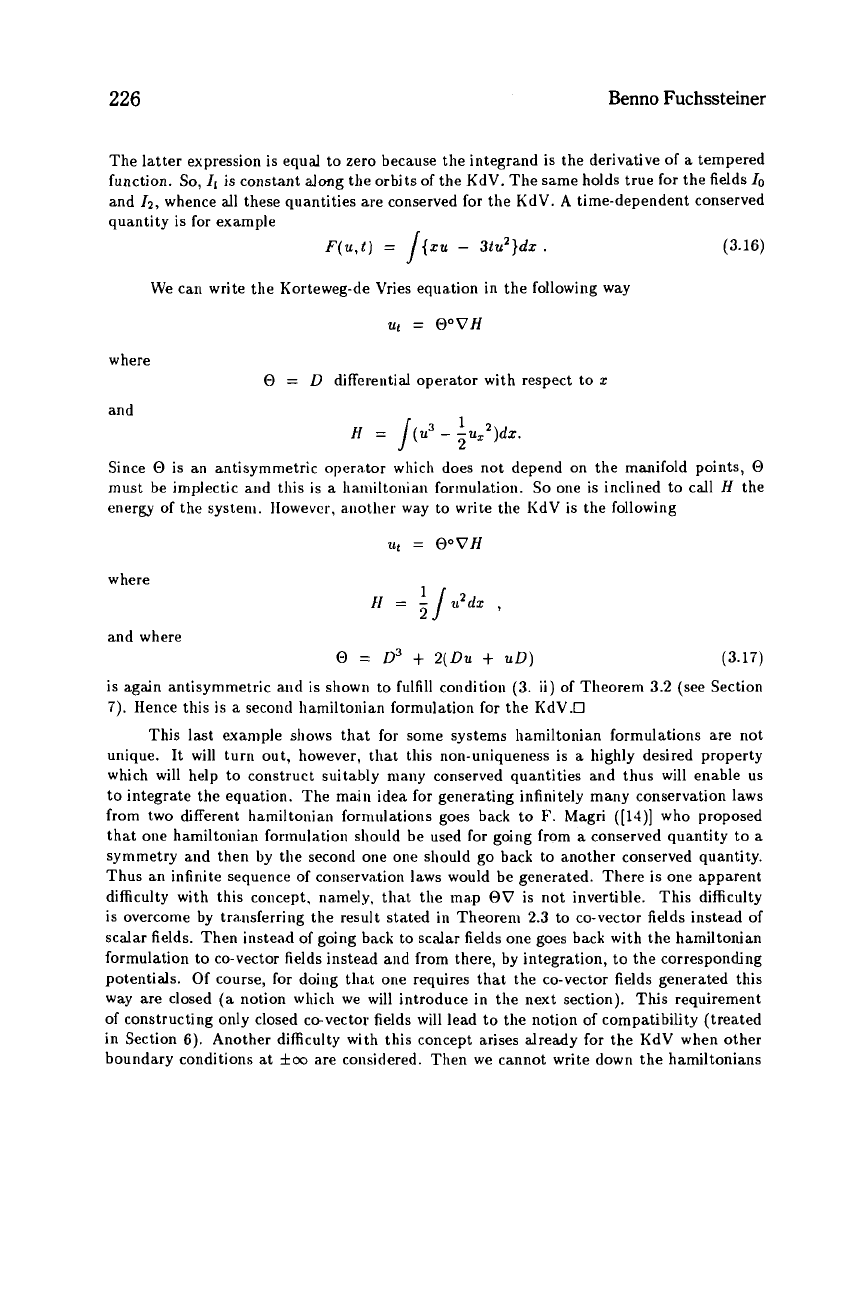
226
Eknno
Fuchssteiner
The latter expression is equal to zero because the integrand is the derivative of
a
tempered
function.
So,
11
is constant along the orbits of the KdV. The same holds true for the fields
Zo
and
I*,
whence
all
these quantities are conserved for the KdV. A time-dependent conserved
quantity is for example
F(u,t)
=
/{xu
-
3tu')dz
.
(3.16)
We can write the Korteweg-de Vries equation in the following way
Ut
=
O'VH
where
0
=
D
differential operator with respect to
z
€1
=
/(u3
-
-uZ2)dz.
Since
0
is
an
antisymmetric operator which does not depend on the manifold points,
0
must be implectic and this is
a
hainiltonian formulation.
So
one
is
inclined to call
H
the
energy
of
the system. Itowever, another way to write the KdV
is
the following
and
1
2
tlt
=
OOVH
where
and where
n
=
-
2dZ
,
2
'J
0
=
D3
+
2(Du
+
uD)
(3.17)
is again antisymmetric and is shown to fulfill condition
(3.
ii)
of
Theorem
3.2
(see Section
7).
Hence this
is
a
second liamiltonian formulation for the KdV.0
This last example shows that for some systems hamiltonian formulations are not
unique. It will turn out, however, that this non-uniqueness is
a
highly desired property
which will help to construct suitably many conserved quantities and thus will enable us
to integrate the equation. The main idea for generating infinitely many conservation laws
from two different hamiltonian formulations goes back to
F.
Magri
([la)]
who proposed
that one hamiltonian formulation should be used for going from
a
conserved quantity to
a
symmetry and then by the second one one should go back to another conserved quantity.
Thus an infinite sequence
of
conservation laws would be generated. There is one apparent
difficulty with this concept, namely, that the map
OV
is not invertible.
This difficulty
is overcome by transferring the result stated in Theorem
2.3
to co-vector fields instead of
scalar fields. Then instead
of
going back to scalar fields one goes back with the hamiltonian
formulation to co-vector fields instead and from there, by integration, to the corresponding
potentials. Of course, for doing that one requires that the co-vector fields generated this
way are closed (a notion which we will introduce in the next section). This requirement
of
constructing only closed co-vector fields will lead to the notion
of
compatibility (treated
in Section
6).
Another difficulty with this concept arises already for the KdV when other
boundary conditions at
foo
are considered. Then we cannot write down the hamiltonians
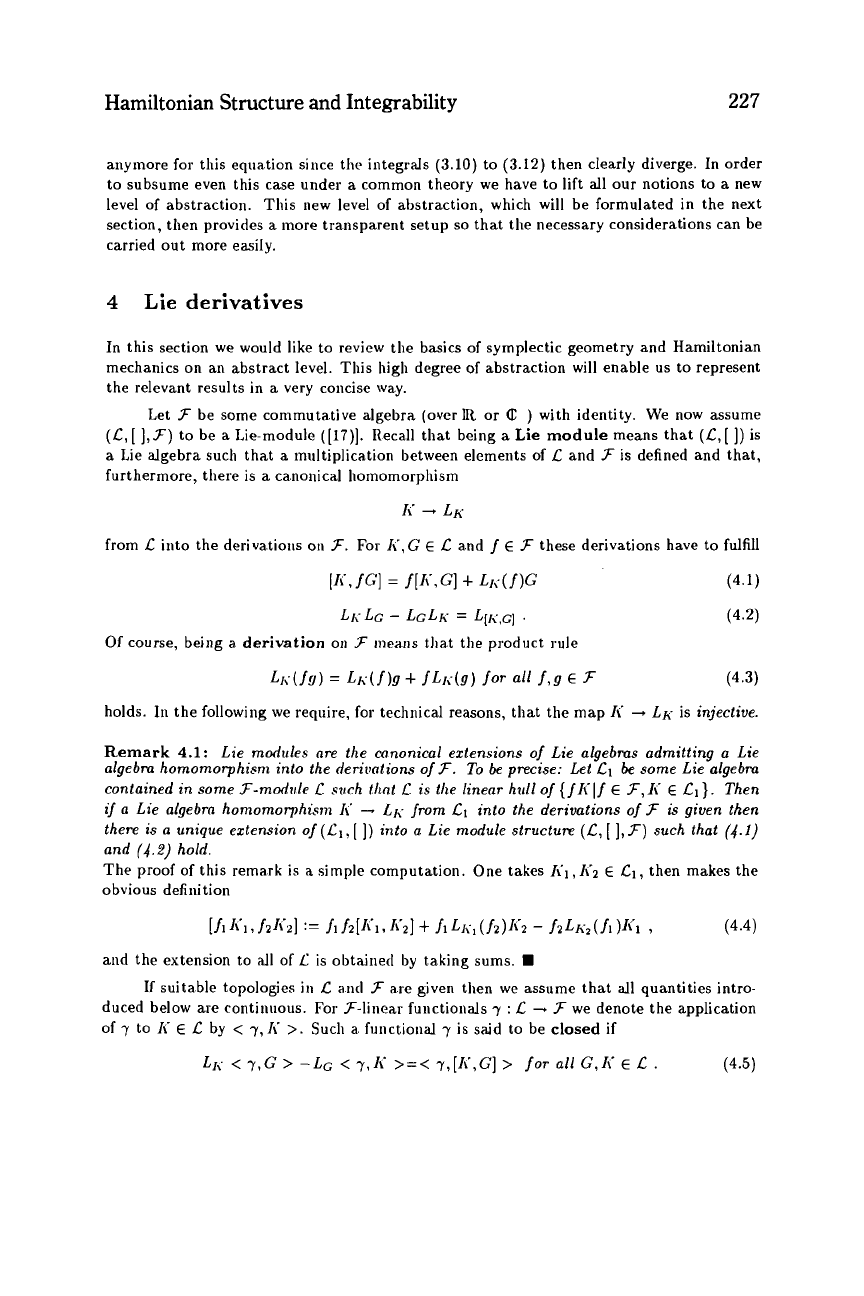
Hamiltonian Structure and Integrability
227
anymore for this equation since the integrals
(3.10)
to
(3.12)
then clearly diverge. In order
to subsume even this case under
a
common theory we have to lift all our notions to
a
new
level of abstraction. This new level
of
abstraction, which will be formulated in the next
section, then provides
a
more transparent setup
so
that the necessary considerations can be
carried out more easily.
4
Lie
derivatives
In this section we would like to review the basics
of
symplectic geometry and Hamiltonian
mechanics on an abstract level. This high degree
of
abstraction will enable
us
to represent
the relevant results in
a
very concise way.
Let
3
be some commutative algebra (overlR
or
C
)
with identity. We now assume
(C,[
],3)
to be
a
Lie-module
([17)].
Recall that being
a
Lie module
means that
(L,[
1)
is
a
Lie algebra such that
a
multiplication between elements
of
C
and
3
is defined and that,
furthermore, there is
a
canonical homomorphism
I;
-
LK
from
C
into the derivations
on
3.
For
I<,G
E
C
and
f
E
3
these derivations have to fulfill
[I<,
fG]
=
f[I<,G]
t
Lii(
f)C
Liik
-
LGLK
=
L[I~,C]
.
Li,(fg)
=
Li,(f)g
t
fLii(9)
for
all
f,g
E
3
(4.1)
(4.2)
Of
course, being a
derivation
on
F
ineans tliat the product rule
(4.3)
holds.
In
the following we require, for technical reasons, that the map
I<
+
LK
is
injective.
Remark
4.1:
Lie modules are the canonical extensions
of
Lie algebras admitting a Lie
algebm homomorphism into the derivations
of
3.
To be precise: Let
C1
be
some Lie algebm
contained in some 3-mdiile
C
svch
tlint
C
is the linear hull
of
{
fI<l
f
E
3,
Ii
E
Ll}.
Then
if
a Lie algebra homomorphism
Ii
-
Lii
from
Cl
into the derivations
of
3
is
given then
there
is
a unique extension
of
(Cl,[
1)
into a Lie module structure
(C,
[
],3)
such that
(4.1)
and
(4.2)
hold.
The proof
of
this remark is
a
simple computation. One takes
A'l,
Iiz
E
Cl,
then makes the
obvious definition
[fiIC1,fzIC2]
:=
fifi[Iii,ICz]
t
fiL~i](fi)IC~
-
fzLK2(h)IiF1
,
(4.4)
and the extension to all
of
L
is obtained by taking sums.
If suitable topologies
iti
C
and
3
are given then we assume that all quantities intro-
duced below are continuous. For 3-linear functionals
y
:
C
-
3
we denote the application
of
y
to
I<
E
C
by
<
y,l<
>.
Such
a.
functional
y
is said to be
closed
if
Lii
<
y,G
>
-LG
<
y,IC
>=<
y,[Ii,G]
>
for
all
G,IC
E
C.
(4.5)
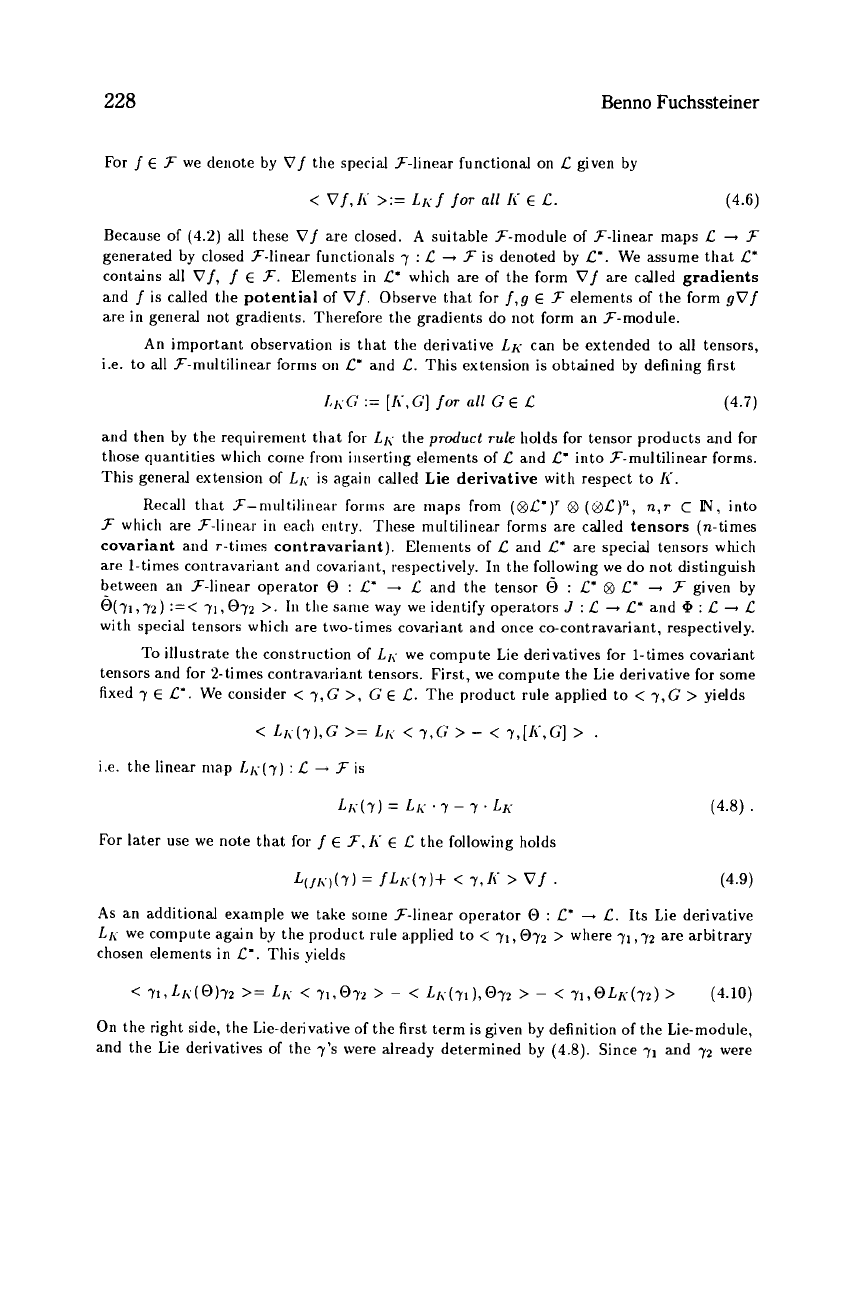
228
Benno
Fuchssteiner
For
f
E
3
we denote by
V
f
the special 3-linear functional on
L
given by
<
V
f,li
>:=
Lli
f
for
all
I<
E
C.
(4.6)
Because
of
(4.2)
all these
V
f
are closed. A suitable 3-module of 7-linear maps
C
+
3
generated by closed 3-linear functionals
y
:
L
+
3
is denoted by
C'.
We assume that
L*
contains all
Vf,
f
E
3. Elements in
L'
which are
of
the form
Of
are called gradients
and
f
is called the potential
of
Of.
Observe that for
f,g
E
3
elements
of
the form
gV
f
are in general not gradients. Therefore the gradients do not form an 7-module.
An important observation is that the derivative
LK
can be extended to all tensors,
i.e. to all 3-multilinear forms
on
L*
and
L.
This extension is obtained by defining first
LliG
:=
[Ii,G]
for
all
G
E
L
(4.7)
and then by the requirement that
for
LI;
the
product
rule
holds for tensor products and for
those quantities which
come
from inserting elements
of
L
and
L*
into 3-multilinear forms.
This general extension of
LI;
is agaiii called Lie derivative with respect to
K.
Recall that 3-niiilt.ilinear forms are
maps
from
(@L*)'
@
(@L)",
n,r
c
N,
into
3
which are 3-linear
in
each
rritry. These multi1inea.r forms are called tensors (n-times
covariant and r-times contravariant). Elements
of
L
and
L*
are special tensors which
are 1-times contravariant and cova.riant, respectively. In the following we do not distinguish
between an 3-linear operator
0
:
L*
-
L
and the tensor
6
:
L*
@
L*
-
3
given by
O(yl,
yz)
:=<
yl,
072
>.
In
the same way we identify operators
J
:
L
-
L*
and
@
:
L
+
L
with special tensors which are two-times covariant and once co-contravariant, respectively.
To
illustrate the construction
of
LI;
we compute Lie derivatives for 1-times covariant
tensors and for 2-times contrava.riant tensors. First, we compute the Lie derivative for some
ule applied to
<
y,G
>
yields
Ii,C]
>
(4.8)
.
For later use we note that
for
f
E
3,
A'
E
C
the following holds
L(jii)(Y)
=
fLii(y)+
<
Y~IL
>
Of.
(4.9)
As an additional example we take some 3-linear operator
0
:
L*
-
L.
Its Lie derivative
Lii
we compute again by the product rule a.pplied to
<
y1,Oyz
>
where
yI,y2
are arbitrary
chosen elements in
L*.
This yields
<
YI*LI~(~)YZ
>=
Lii
<
y1.0~2
>
-
<
Lii(yl),OyZ
>
-
<
YI~OLK(~Z)
>
(4.10)
On
the right side, the Lie-derivative of the first term
is
given by definition
of
the Lie-module,
and the Lie derivatives
of
the
y's
were already determined by
(4.8).
Since
y1
and
yz
were
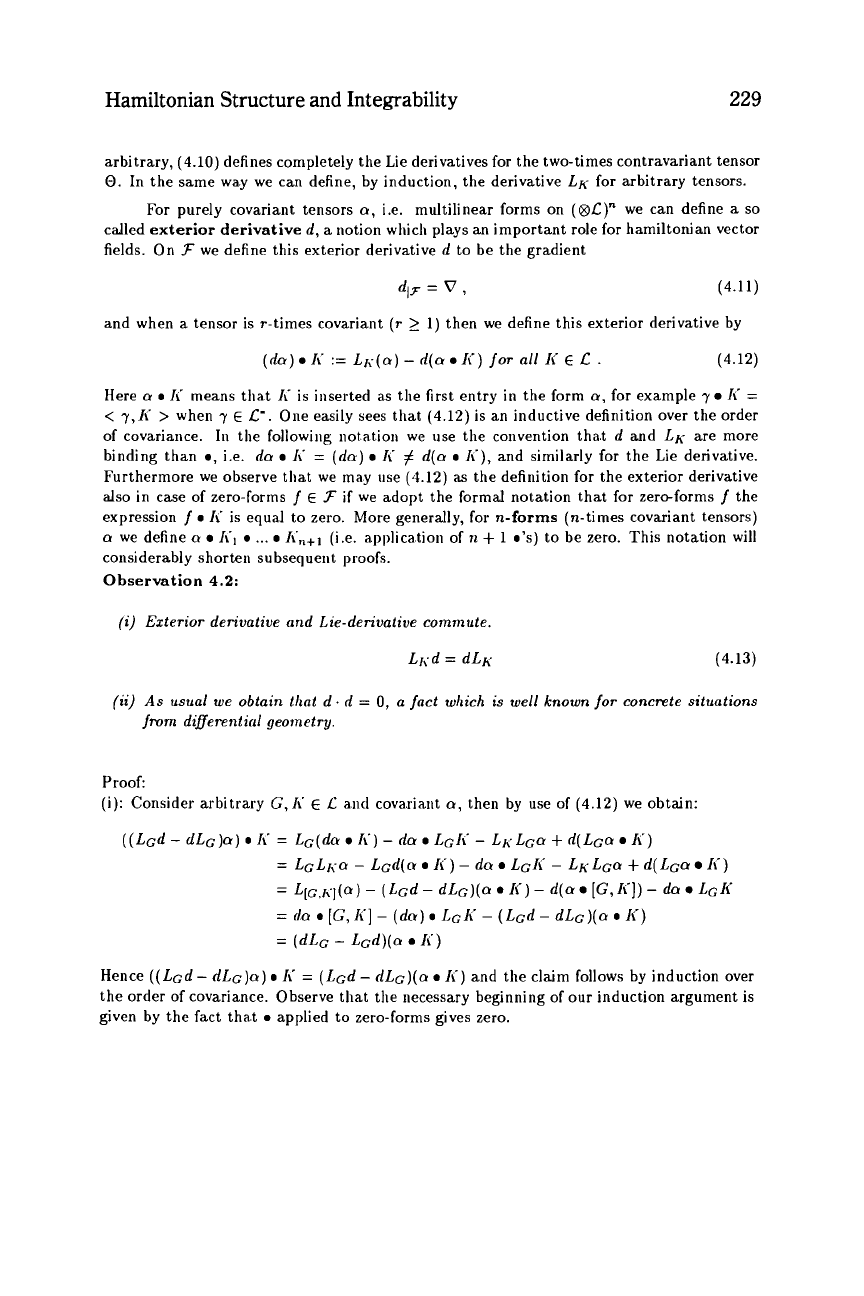
Hamiltonian Structure and Integrability
229
arbitrary,
(4.10)
defines completely the Lie derivatives for the two-times contravariant tensor
0.
In the same way we can define, by induction, the derivative
LH.
for arbitrary tensors.
For purely covariant tensors
a,
i.e. multilinear forms on
(@JL)~
we can define
a
so
called exterior derivative
d,
a
notion which plays an important role for hamiltonian vector
fields. On
3
we define this exterior derivative
d
to be the gradient
dl3
=
v
7
(4.11)
and when
a
tensor is r-times covariant
(r
2
1)
then we define this exterior derivative by
(da)
0
Ii
:=
L/i(a)
-
d(a
0
Ii)
for all
6
E
L:
.
(4.12)
Here
a
0
Ii
means that
li
is inserted as the first entry
in
the form
a,
for example
y
li
=
<
y,Ii
>
when
y
E
L*.
One easily sees that
(4.12)
is an inductive definition over the order
of
covariance.
In
the following notation we use the convention that
d
and
LK
are more
binding than
0,
i.e.
da
I<
=
(da)
li
#
d(a
0
li),
and similarly for the Lie derivative.
Furthermore we observe that we may
use
(4.12)
as
the definition for the exterior derivative
also
in case
of
zero-forms
J
E
3
if
we adopt the formal notation that for zero-forms
f
the
expression
f
0
Ii
is equal to zero. More generally, for n-forms (n-times covariant tensors)
a
we define
a
Iil
0
...
0
(i.e. application
of
n
+
1
0’s)
to be zero. This notation will
considerably shorten subsequent proofs.
Observation
4.2:
(i) Exterior derivative and Lie-derivative commute.
L/;d
=
dLK
(4.13)
(ii)
As
usual we obtain
that
d.
d
=
0,
a fact which
is
well known for concrete situations
from differential geometry.
Proof
(i): Consider arbitrary
G,Ii
E
C
and covariant
a,
then by use
of
(4.12)
we obtain:
((Lcd-
dLc)a).
Ii
=
Lc(da
0
I<)
-
dff
0
LGIi
-
L,;Lca
+
d(Lca0li)
=
LG Liia
-
Lcd(a
a
Ii)
-
da
a
Lcli
-
LK Lca
+
d(
Lccr
A’)
=
L[G,/;I(~)
-
(Lcd
-
dLc)(a
0
A’)
-
d(0
[G,li])
-
da
LGIC
=
r/a*[G,Ii]-
(da).
LcIi
-
(Lcd-dLc)(a*
I<)
=
(dLG
-
Lcd)(a
0
I<)
Hence
((Lcd
-
dLc)a)
0
Ii
=
(Lcd
-
dLc)(a
0
li)
and the claim follows by induction over
the order of covariance. Observe that the necessary beginning
of
our induction argument is
given by the fact that
0
applied to zero-forms gives zero.
